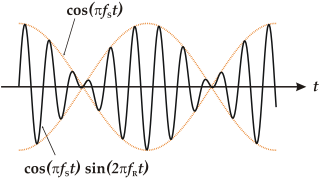Related Research Articles

Acoustics is a branch of physics that deals with the study of mechanical waves in gases, liquids, and solids including topics such as vibration, sound, ultrasound and infrasound. A scientist who works in the field of acoustics is an acoustician while someone working in the field of acoustics technology may be called an acoustical engineer. The application of acoustics is present in almost all aspects of modern society with the most obvious being the audio and noise control industries.

A harmonic series is the sequence of harmonics, musical tones, or pure tones whose frequency is an integer multiple of a fundamental frequency.

Pitch is a perceptual property of sounds that allows their ordering on a frequency-related scale, or more commonly, pitch is the quality that makes it possible to judge sounds as "higher" and "lower" in the sense associated with musical melodies. Pitch is a major auditory attribute of musical tones, along with duration, loudness, and timbre.

A harmonic sound is said to have a missing fundamental, suppressed fundamental, or phantom fundamental when its overtones suggest a fundamental frequency but the sound lacks a component at the fundamental frequency itself. The brain perceives the pitch of a tone not only by its fundamental frequency, but also by the periodicity implied by the relationship between the higher harmonics; we may perceive the same pitch even if the fundamental frequency is missing from a tone.

Active noise control (ANC), also known as noise cancellation (NC), or active noise reduction (ANR), is a method for reducing unwanted sound by the addition of a second sound specifically designed to cancel the first. The concept was first developed in the late 1930s; later developmental work that began in the 1950s eventually resulted in commercial airline headsets with the technology becoming available in the late 1980s. The technology is also used in road vehicles, mobile telephones, earbuds, and headphones.
In psychoacoustics and signal processing, a pure tone is a sound or a signal with a sinusoidal waveform; that is, a sine wave of any frequency, phase-shift, and amplitude.
Sound localization is a listener's ability to identify the location or origin of a detected sound in direction and distance.
Musical acoustics or music acoustics is a multidisciplinary field that combines knowledge from physics, psychophysics, organology, physiology, music theory, ethnomusicology, signal processing and instrument building, among other disciplines. As a branch of acoustics, it is concerned with researching and describing the physics of music – how sounds are employed to make music. Examples of areas of study are the function of musical instruments, the human voice, computer analysis of melody, and in the clinical use of music in music therapy.

In acoustics, a beat is an interference pattern between two sounds of slightly different frequencies, perceived as a periodic variation in volume whose rate is the difference of the two frequencies.

Volley theory states that groups of neurons of the auditory system respond to a sound by firing action potentials slightly out of phase with one another so that when combined, a greater frequency of sound can be encoded and sent to the brain to be analyzed. The theory was proposed by Ernest Wever and Charles Bray in 1930 as a supplement to the frequency theory of hearing. It was later discovered that this only occurs in response to sounds that are about 500 Hz to 5000 Hz.

Helmholtz resonance or wind throb is the phenomenon of air resonance in a cavity, such as when one blows across the top of an empty bottle. The name comes from a device created in the 1850s by Hermann von Helmholtz, the Helmholtz resonator, which he used to identify the various frequencies or musical pitches present in music and other complex sounds.

Hearing range describes the range of frequencies that can be heard by humans or other animals, though it can also refer to the range of levels. The human range is commonly given as 20 to 20,000 Hz, although there is considerable variation between individuals, especially at high frequencies, and a gradual loss of sensitivity to higher frequencies with age is considered normal. Sensitivity also varies with frequency, as shown by equal-loudness contours. Routine investigation for hearing loss usually involves an audiogram which shows threshold levels relative to a normal.

The Savart wheel is an acoustical device named after the French physicist Félix Savart (1791–1841), which was originally conceived and developed by the English scientist Robert Hooke (1635–1703).
The ASA Silver Medal is an award presented by the Acoustical Society of America to individuals, without age limitation, for contributions to the advancement of science, engineering, or human welfare through the application of acoustic principles or through research accomplishments in acoustics. The medal is awarded in a number of categories depending on the technical committee responsible for making the nomination.

August Ludwig Friedrich Wilhelm Seebeck was a scientist at the Technische Universität Dresden.

In physics, sound is a vibration that propagates as an acoustic wave, through a transmission medium such as a gas, liquid or solid. In human physiology and psychology, sound is the reception of such waves and their perception by the brain. Only acoustic waves that have frequencies lying between about 20 Hz and 20 kHz, the audio frequency range, elicit an auditory percept in humans. In air at atmospheric pressure, these represent sound waves with wavelengths of 17 meters (56 ft) to 1.7 centimeters (0.67 in). Sound waves above 20 kHz are known as ultrasound and are not audible to humans. Sound waves below 20 Hz are known as infrasound. Different animal species have varying hearing ranges.

William M. Hartmann is a noted physicist, psychoacoustician, author, and former president of the Acoustical Society of America. His major contributions in psychoacoustics are in pitch perception, binaural hearing, and sound localization. Working with junior colleagues, he discovered several major pitch effects: the binaural edge pitch, the binaural coherence edge pitch, the pitch shifts of mistuned harmonics, and the harmonic unmasking effect. His textbook, Signals, Sound and Sensation, is widely used in courses on psychoacoustics. He is currently a professor of physics at Michigan State University.
Psychoacoustics is the branch of psychophysics involving the scientific study of sound perception and audiology—how human auditory system perceives various sounds. More specifically, it is the branch of science studying the psychological responses associated with sound. Psychoacoustics is an interdisciplinary field of many areas, including psychology, acoustics, electronic engineering, physics, biology, physiology, and computer science.
Ernst Terhardt is a German engineer and psychoacoustician who made significant contributions in diverse areas of audio communication including pitch perception, music cognition, and Fourier transformation. He was professor in the area of acoustic communication at the Institute of Electroacoustics, Technical University of Munich, Germany.
Auditory science or hearing science is a field of research and education concerning the perception of sounds by humans, animals, or machines. It is a heavily interdisciplinary field at the crossroad between acoustics, neuroscience, and psychology. It is often related to one or many of these other fields: psychophysics, psychoacoustics, audiology, physiology, otorhinolaryngology, speech science, automatic speech recognition, music psychology, linguistics, and psycholinguistics.
References
- ↑ Ohm's law, n.2, Oxford English Dictionary , 2nd ed.
- ↑ A. Wilmer Duff, ed. (1912). A Text-book of Physics. Philadelphia: P. Blakiston's Son & Co.
- ↑ Ohm, G., Annalen der Physik (1843) 59 513
- ↑ Dayton Clarence Miller (1916). The Science of Musical Sounds. The Macmillan Company. ISBN 9781404791275.
- ↑ Charles Lightfoot Barnes (1897). Lessons in Elementary Practical Physics, Vol. III, Part 1: Practical Acoustics. London: Macmillan and Co. Ltd.
- ↑ Joseph Peterson (1908). Combination Tones and Other Related Auditory Phenomena. University of Chicago.
- ↑ David M. Howard, Jamie A. S. Angus (2006). Acoustics and psychoacoustics. Focal Press. p. 123. ISBN 978-0-240-51995-1.
- ↑ John Borwick (2001). Loudspeaker and Headphone Handbook. Focal Press. ISBN 0-240-51578-1.
- ↑ W. Dixon Ward (1970). "Musical Perception". In Jerry V. Tobias (ed.). Foundations of Modern Auditory Theory. Vol. 1. Academic Press. p. 438.